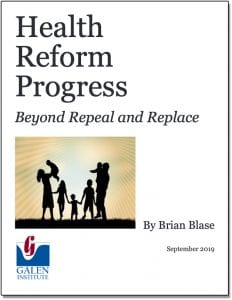From the start of 2017 through the fall of that year, Congress labored to pass legislation to replace large parts of the Affordable Care Act. Ultimately, political obstacles proved insurmountable, and Congress was unable to enact a health reform bill. Soon after that failure, President Trump signed an executive order promoting health care choice and competition and directing the administration to issue rules expanding more affordable options, principally for middle-income families and small employers and their employees.
Over the next 20 months, the administration issued three major rules expanding coverage through Association Health Plans, short-term limitedduration insurance, and Health Reimbursement Arrangements. These rules, combined with Congress eliminating the penalty associated with the ACA’s individual mandate, have achieved many key objectives, including enhancing consumer choice of coverage, returning some insurance regulatory oversight from the federal government to states, and making health insurance subsidies fairer.
In addition to these key rules, the Trump Administration has taken several steps to improve the ACA’s individual insurance market by reducing peoples’ ability to wait until they are sick to purchase coverage and approving state waivers for programs to separately subsidize high cost enrollees. The administration also has made it easier for people with chronic conditions to benefit from Health Savings Accounts and for states to reform their health insurance markets.
Serious challenges remain, including enrollment abuses and cost overruns from the ACA’s Medicaid expansion as well as an individual market in many states where premiums are unaffordable for people not eligible for subsidies. Although there is still a profound need for congressional action to address these problems as well as other policies that drive higher health care costs, the Trump Administration has a strong record of health policy accomplishment and has set a bold vision for health reform centered on empowering consumers and promoting competition among providers.


